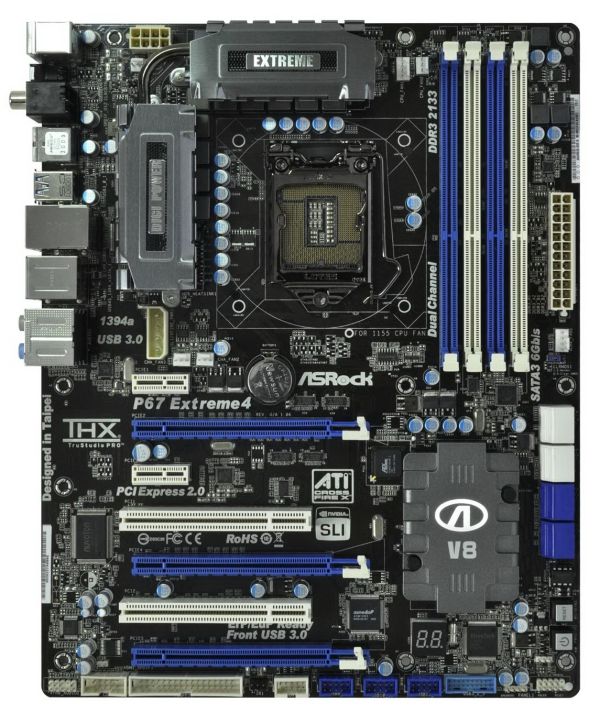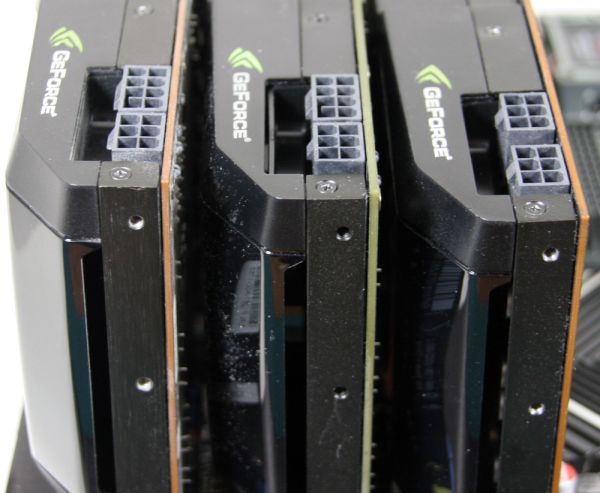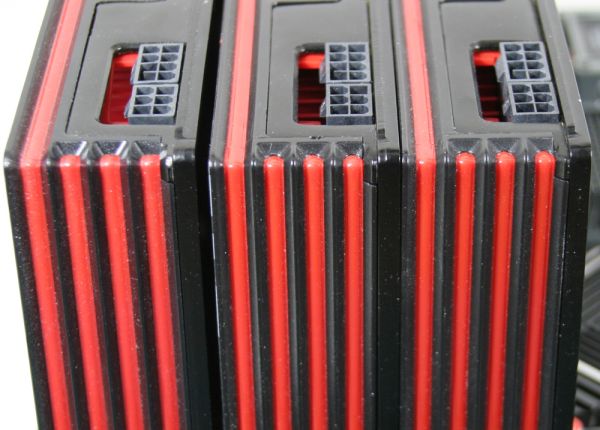A Look At Triple-GPU Performance And Multi-GPU Scaling, Part 1
by Ryan Smith on April 3, 2011 7:00 AM ESTFitting Three Video Cards in an ATX Case
I thought we’d flip our normal GPU review style on its head by starting with Power, Temperature, and Noise first. NVIDIA and AMD have both long recommended against placing high-end video cards directly next to each other, in favor of additional spacing between video cards. Indeed this is a requirement for their latest dual-GPU cards, as both the GTX 590 and 6990 draw relatively massive amounts of air using a fan mounted at the center of the card and exhaust roughly half their air inside of the case. Their reference style single-GPU cards on the other hand are fully exhausting with fans mounted towards the rear of the card. Thus multi-GPU configurations with the cards next to each other is supposed to be possible, though not ideal.
There’s a reason I want to bring this up first, and a picture is worth a thousand words.
While AMD and NVIDIA’s designs share a lot in common – a rear-mounted blower fan pushes air over a vapor chamber cooler – the shrouds and other external equipment are quite different. It’s not until we see a picture that we can appreciate just how different they are.
With the Radeon HD 6000 series, AMD’s reference designs took on a very boxy design. The cards fully live up to the idea of a “black box”; they’re enclosed on all sides with a boxy cooler and a black metal backplate. As a GPU reviewer I happen to like this design as the GPUs are easy to stack/store, and the backplate covers what would normally be the only exposed electronics on the card. The issue with this boxy design is that AMD is taking full advantage of the PCIe specification, leading to the 6900 series being the full width allowed.
NVIDIA on the other hand has always had some kind of curve in their design, normally resulting in a slightly recessed shroud around the blower intake. For the GTX 580 and GTX 570 they took a further step in recessing the shroud around this area, leading to the distinct wedge shape. At the same time NVIDIA does not use a backplate, saving precious millimeters of space. The end result of this is that even when packed like sardines, the GTX 580 and GTX 570 blowers have some space reserved for air intake.
The Radeon HD 6970 does not, and this is our problem. The picture of the 6970 in triple-CF really paints the picture, as the middle card is directly pressed up against the top card. Because these cards are so large and heavy the rear ends tend to shift and dip some when installed against a vertical motherboard – in fact this is why we can normally get away with a dense dual-CF setup since the bottom card dips a bit more – but in a triple-CF configuration the end result is that one of the cards will end up getting up-close and personal with another one.
Without outside intervention this isn’t usable. We hit 99C on the middle card in Crysis when we initially installed the three cards, and Crysis isn’t the hardest thing we run. For the purposes of our test we ultimately resorted to wedging some space between the cards with wads of paper, but this isn’t a viable long-term solution.
Unfortunately long-term alternatives are few if you want to give a triple-GPU setup more space. Our testbed uses an Asus Rampage II Extreme, which features three PCIe slots mixed among a total of 6 slots; the way it’s laid out makes it impossible to have our triple-GPU configuration setup in any other manner. Even something like the ASRock P67 Extreme4 can’t escape the fact that the ATX spec only has room for 7 slots and that when manufacturers actually use the 7th and topmost slot that it’s a short PCIe x1 slot. In short you won’t find an ATX motherboard that can fit three video cards and at the same time gives each one a slot’s worth of breathing room. For that you have to use a larger than ATX form factor.

So what’s the point of all of this rambling? With AMD’s current shroud design it’s just not practical to do triple-CF on air on an ATX motherboard. If you want to play with three AMD boards you need to think outside of the box: either use water cooling or use a larger motherboard.












97 Comments
View All Comments
Ryan Smith - Sunday, April 3, 2011 - link
It took awhile, but we finally have 3 120Hz 1080P monitors on the way. So we'll be able to test Eyefinity, 3D Vision, and 3D Vision Surround; all of which have been neglected around here.Kaboose - Sunday, April 3, 2011 - link
I await these tests with breathless anticipation!veri745 - Sunday, April 3, 2011 - link
While this article was very well written, I think it is hardly worth it without the multi-monitor data. No-one (sane) is going to get 3x SLI/CF with a single monitor, so it's mostly irrelevant.The theoretical scaling comparison is interesting, but I'm a lot more interesting in the scaling at 3240x1920 or 5760x1080.
DanNeely - Sunday, April 3, 2011 - link
This is definitely a step in the right direction; but with other sites having 3x 1920x1200 or even 3x 2560x1600 test setups you'll still be playing catchup.RK7 - Sunday, April 3, 2011 - link
Finally! I created account just to write that comment :) That's what's missing and what definitely needs to be tested! Especially 3D Vision Surround - it's good to know if it's worth to put so much money into such setup, because single card may be on the edge of performance for modern games in stereoscopic mode with single monitor (good example is Metro 2033, that blows mind when in 3D, but I found with single GTX 570@900MHz is playable only at 1600x900 in 3D with maximum settings without DoF and AA, and even in such case it could drop for some action scenes with heavy lighting to ~12 fps...). So if three cards can achieve a good scaling and provide performance per monitor for 3 monitors setup close to single card for one monitor, then we're there and it's worth it definitely, but if numbers will be alike to those for single monitor scaling, then folks should be aware that there's no way for maximum visual quality gaming with current hardware on 3 monitors...Dustin Sklavos - Monday, April 4, 2011 - link
Not completely neglected. I've added triple-monitor surround testing to my boutique desktop reviews whenever able. :)Crazymech - Sunday, April 3, 2011 - link
I'm having my doubts about the capabilities of the 920 OC'd to 3.33 GHz matched up with 3 of the most powerful single GPUs.I understand straying away from SB because of the lanes, but you could at least have upped the OC to 3,8-4, which many people do (and I would think most that considers a tripple setup would use).
To underline it I point to the small differences between the 4.5 GHz 2600K and the lower overclocked one in the boutique builds reviews, with the highest clocked CPU coupled with weaker GPU's nipping at the heels of the more powerful GPU.
I suggest you at least experiment in a single test (say metro for example.. or battlefield) what a higher clocked X58 (or the 980's 6 cores) could do to the setup.
If I'm wrong, it would at least be good to know that.
BrightCandle - Sunday, April 3, 2011 - link
The fact that sandy Bridge has a PCI-E lanes problem is grounds for testing the impact.Still I would rather see the numbers on X58 and triple screen gaming before seeing the impact that SB makes the performance of SLI/CF setups.
Ryan Smith - Sunday, April 3, 2011 - link
For what it's worth, 3.33GHz is actually where this specific 920 tops out. It won't take 3.5GHz or higher, unfortunately.We'll ultimately upgrade our testbed to SNB - this article is the impetus for that - but that's not going to happen right away.
Crazymech - Monday, April 4, 2011 - link
It wont take 3.5? Really? That amazes me.Though very unfortunate for the purpose of this test.
The main focus is (of course) always on how the new GPU in relation to a standard CPU improves the framerate, but once in a while it would be interesting what different CPU's do to the GPU and FPS aswell. Like the old Doom III articles of showing Athlon dominating PenIV.
Thanks for the answer anyhows :).